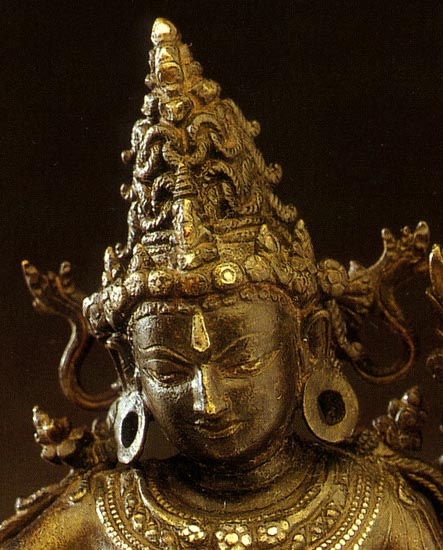
Bodhisattva Maitreya
India (Bihar), 12th century
Bronze with silver and copper inlay, 7 1/4 in (18.2 cm)
Published: Huntington and Huntington 1989, pp. 34-35, fig. 10;
Huntington and Huntington 1990, pp. 176 - 77, no. 49
|
This beautifully crafted bronze the future Buddha Maitreya seated in the royal-ease posture (maharajalila) on a cushion above a lotus with an elaborate base. While such complex supports with luxuriant vine scrolling are not unknown in Pala art, rarely do they have a base shaped like a parallelogram with such prominent bead motifs along the bottom. Richly adorned with silver and copper inlaid jewelry, the bodhisattva, an embodiment of grace and elegance, can be identified by a pot nestled among the lotus flower and leaves held by the left hand, and by the tiny stupa lodged in the base of his tall, elegant, matted hair. Unusual also is the fact that the bronze was separately cast in three pieces and skillfully assembled into a harmonious composition. As if these features are not enough to make this a rare Pala-period bronze of exquisite craftsmanship, it is also distinguished by the attachment of a base-plate below, whose manifest implications have been discussed at length by the Huntingtons. Only in rare instances were Indian bronzes consecrated and sealed in this manner, but the practice was common in Tibet. The Huntingtons are puzzled by this, but a simple explanation might be that the donor, whose name is inscribed on the base plate in Gaudiya characters of the twelfth century, was in fact a visiting Tibetan who used his Sanskrit name, as the piece was commissioned in India. Finally, a few words about the misreading and the incorrect translation of the inscription on the base-plate. To quote the Huntington catalogue: "Of [i.e., given by] the Chamviv(r)a the saint staying at Pam [or the saint belonging to (a sect called) Pamstha?]." As read correctly by G. Bhattacharya (see appendix), the inscription simply states that this was the gift of the learned, elderly Buddhist monk Sadhurakshita. Although we have no idea of the extent of his knowledge, there can be little doubt that he was a man of taste who selected an artist of unusual technical virtuosity and aesthetic sensitivity to fulfill his commission. In fact, a second bronze has recently been discovered that also has a plate at the bottom inscribed with identical inscription (Rossi and Rossi 1999, pp. 8-9). It represents an Avalokiteshvara, though not identified as such in the catalogue, and was certainly a mate to the Ford bronze. Originally, the two must have flanked a splendid image of Buddha Shakyamuni. Detail: close-up
#1 all
text and images © The Trustees of the Walters Art Gallery, Baltimore
|
